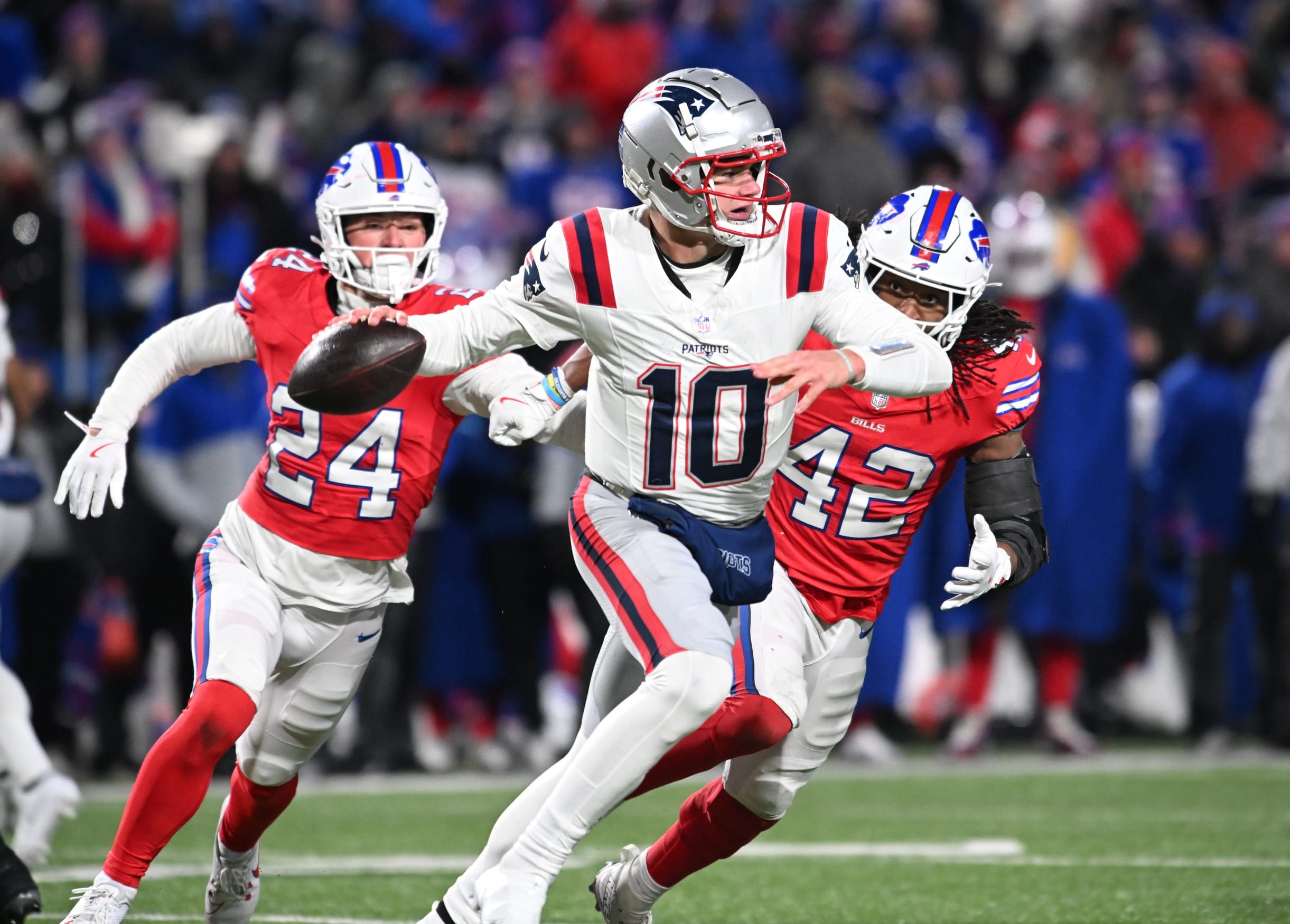
Quick Slant: SNF - Two Suns in the Same Sky
Mat Irby’s Quick Slant
“I think with this field position, you have to just run it out. You have to play for overtime.”
Describing John Madden’s voice as a bullhorn is facile. As tinny or coarse? Possibly, but with nuance, because he also sounds like an ox coming up for air after being submerged underwater.
The Patriots broke the huddle at their own 17, jogging up to the line along Astroturf—carpet on concrete. There were just over 80 seconds left in regulation.
“You don’t want to do anything stupid, because you have no time outs and you’re backed up,” Madden continued. There was a silent parenthetical there: And this kid Tom Brady, a sixth-rounder, who is he? Can you really trust him?
Brady stamped his foot; defenders converged. He abruptly ducked as if a car driving by had backfired, then tossed it out of sheer submission to J.R. Redmond, who immediately took helmets to knees and rug burns to elbows. The drive began with a two-yard dump-off with no shot at getting out of bounds.
After two more checkdowns, Brady hit his back foot and fired a fastball downfield, striking Troy Brown in stride. Brown veered left, shook off a tackle, and stepped out inside the Rams’ 40-yard line. One more dump and a spike, and Adam Vinatieri, three weeks removed from making arguably the most famous field goal in NFL history, stepped forward to hit perhaps its most important one. It was done; the Cinderella Patriots, 14-point underdogs, had toppled the mighty Rams, the Greatest Show on Turf.
Moments later, with the face of a child attached to the body of a man, Brady was tearful and pure, holding the Lombardi Trophy above him. It’s strange to behold in hindsight—a Brady that didn’t expect it, still combing for signs that the confetti was truly for him and his friends—all narrated by a Madden who didn’t know it could ever happen again.
Twenty years later, Brady retired as the undisputed greatest football player ever. The Brady/Belichick Patriots’ winning spanned generations, to the point where even Father Time knew he had pushed the limits; 31 cities stared at him like a parent unwilling to discipline his child. Finally, he did the right thing and let someone else have their chance.
The Bills’ most impressive historical lineage is tied to their losses. Four straight Super Bowl failures—one of pro football’s greatest dynasties from an alternate universe where the AFL and NFL never merged. If Vinatieri’s kick in Super Bowl XXXVI was the league’s most important field goal, Scott Norwood’s shank in Super Bowl XXV was its most notorious miss. It served as the framework for the Four Falls—a first mover on a course of Path Dependence. From there, the K-Gun and its many Hall of Famers—Jim Kelly, Bruce Smith, Thurman Thomas, and Andre Reed—only saw their disappointments grow increasingly embellished, culminating in back-to-back humiliations against the Jimmy Johnson Cowboys, effectively ending an era.
When the Bills thrived in the early 1990s, the Patriots were irrelevant. Buffalo faded just before the Pats became the dynasty of dynasties. And as New England finally fizzled, the Bills rose again with the McDermott/Allen era. The two teams never truly overlapped as contenders.
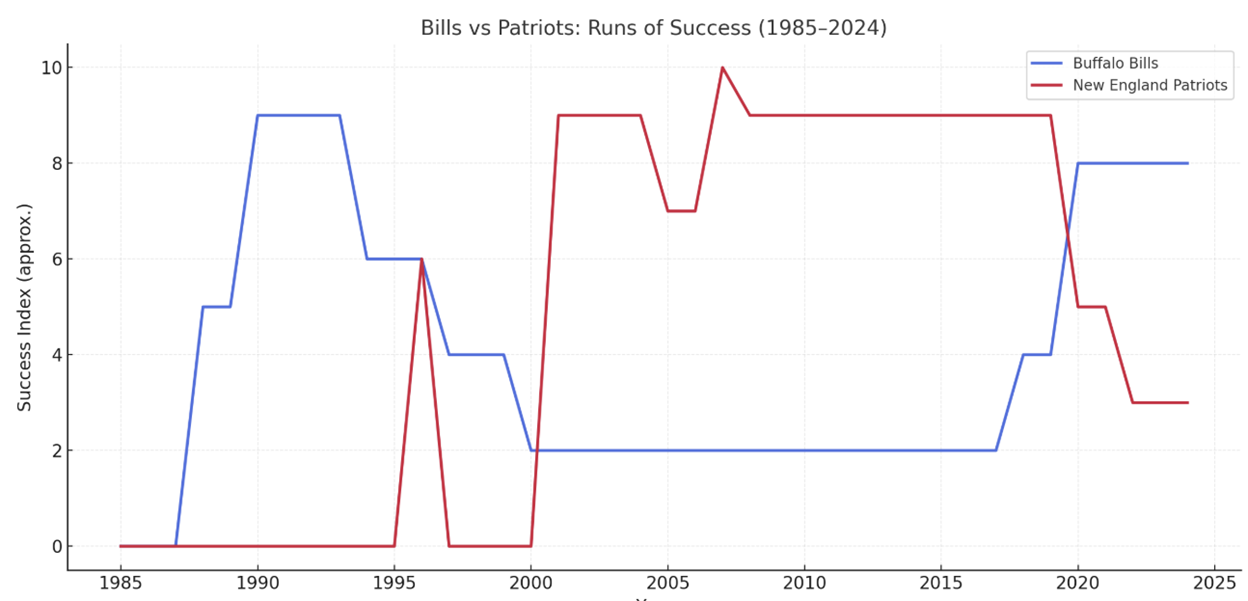
But suddenly, such crossover feels possible. The Patriots have brought in HC Mike Vrabel, a man who was pelted by that same rain of confetti in 2002, his legacy tied to Patriots lore with a weld. His winning culture is undeniable; he made the Titans perennial contenders, often with little more than baling wire and duct tape. In ways, he’s the O.G. Dan Campbell—the tough-as-nails meathead with a genius I.Q.
And he brings with him second-year QB Drake Maye, often compared to a young Josh Allen, to meet the real McCoy. And for once, the game may truly matter. It finally feels like these franchises, which have long been situated for a rivalry that’s never fully matured, could have empires coeval, like two suns rising in the same sky.
But Thursday is a crucial step for a new generation of Patriots to prove they belong in the same plane with these inevitable Bills.
Patriots
Implied Team Total: 20.5
New England ranks 10th in points per game (25.5); they’ve run at a relatively slow pace, taking 27.1 seconds per snap (26th), and they have a positive pass rate over expected (PROE) at +3.2% (3rd).
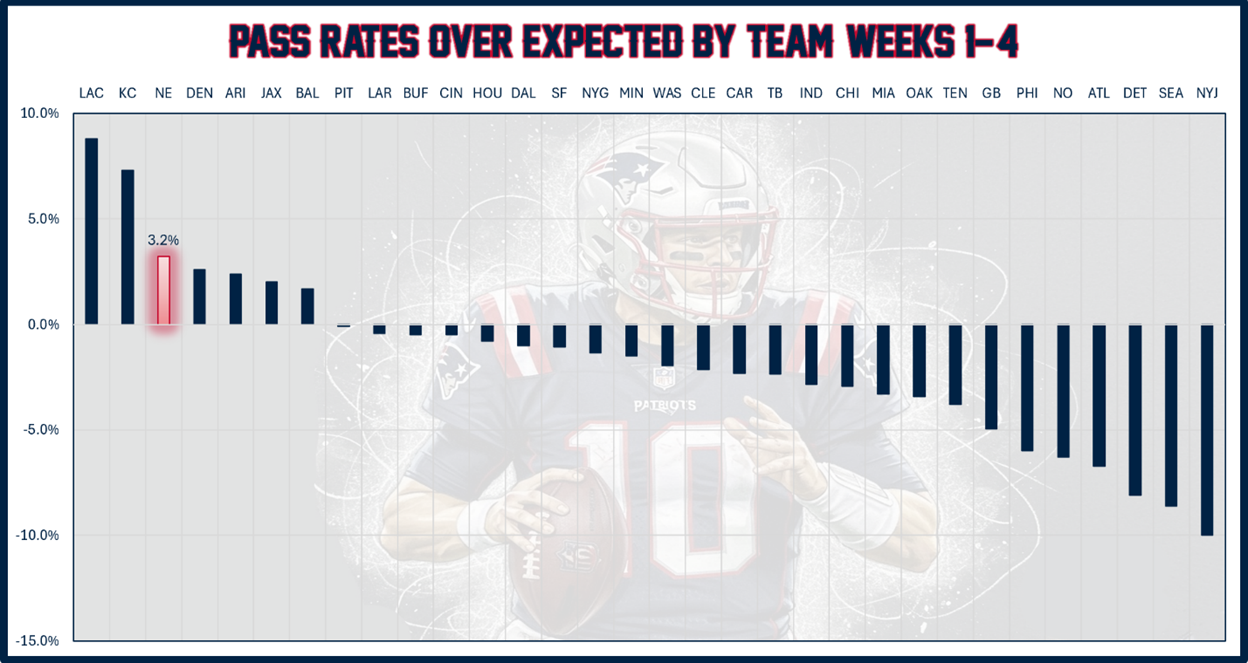
All in, they have run 253 plays (20th), and Maye has dropped back 152 times (T-11th). The Pats have been efficient offensively, ranking ninth in offensive EPA per play and 18th in offensive success rate. They are the most significant outlier in terms of having poor rushing efficiency and positive passing efficiency.
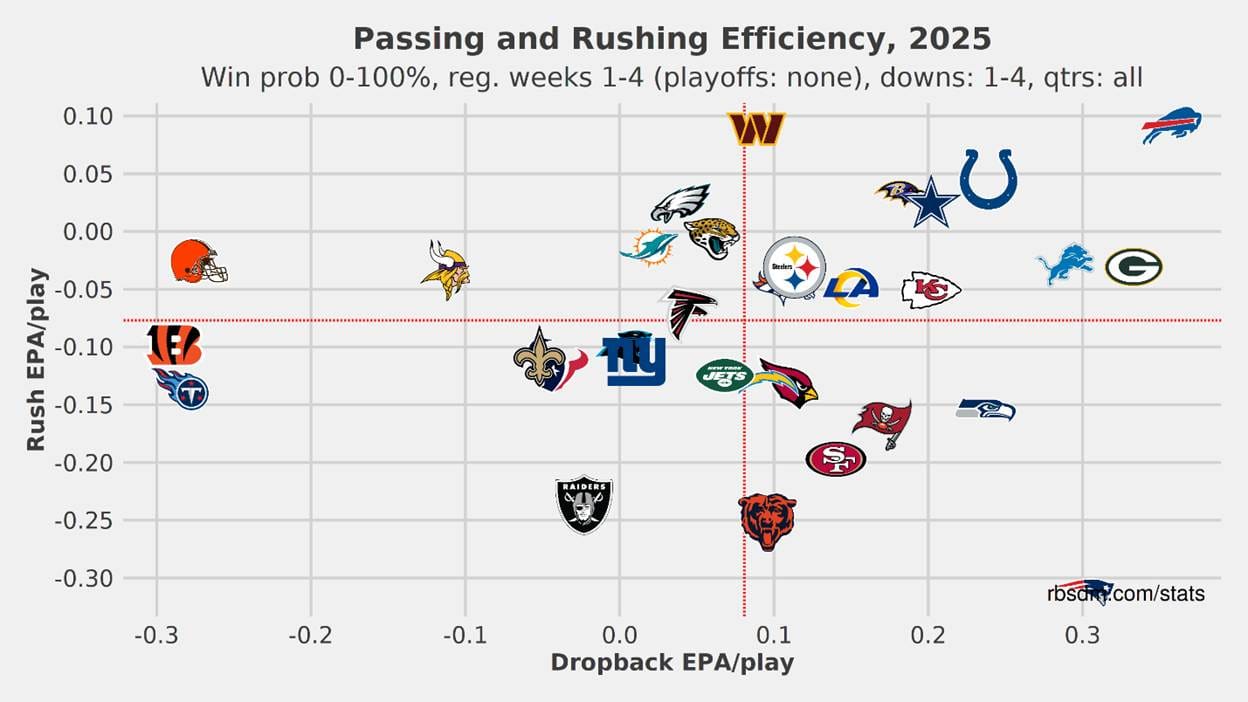
The Patriots are 2-2, but they are tied for eighth in Pythagorean expected wins (10.4), a model based on points for vs. points against. The Bills, contrarily, rank fourth.
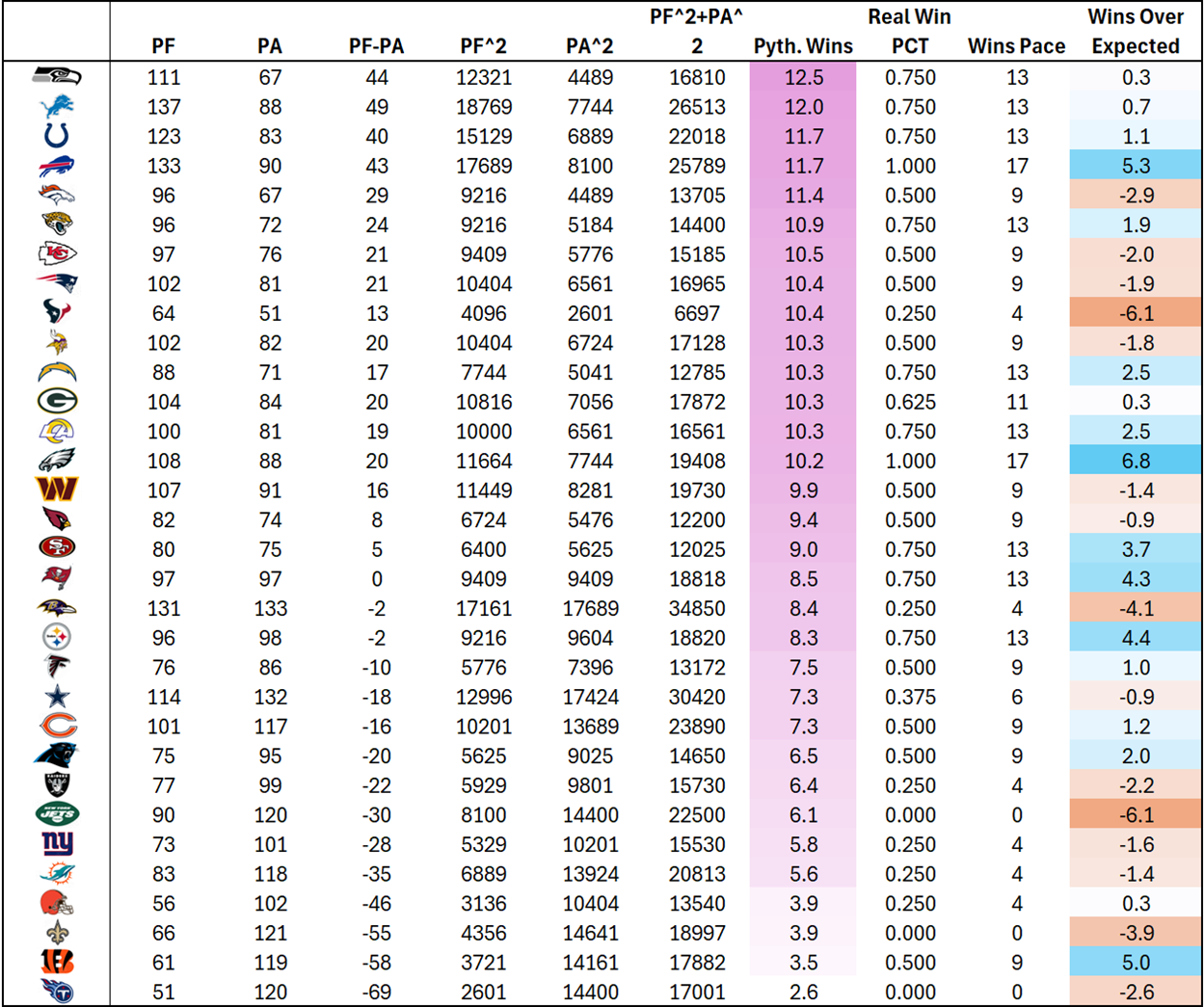
As with any statistic, there is added clarity as the season progresses; Pythagorean Expectation has its flaws, but the information it provides is becoming somewhat reliable at this point. Based on this, and perhaps based on the competitiveness of each of their last two meetings—both in the final three weeks of the season last year—it may be somewhat surprising that this is the second-most lopsided spread of the week (Buffalo, -8.5).
As we’ve no doubt observed in each of my last two write-ups—Packers/Cowboys, followed by Rams/Niners, each of which had at least a 6.5-point spread and resulted in very narrow games decided by a total of three points between them—the NFL continues to be an enigma in parity and tough to predict, particularly in the early frames of the season.
Maye was a popular sleeper pick this summer for both NFL analysts and fantasy-focused ones; thus far, he hasn’t disappointed.
Maye has the best completion percentage in the NFL and ranks in the top ten in several of the most significant statistical categories for a QB.
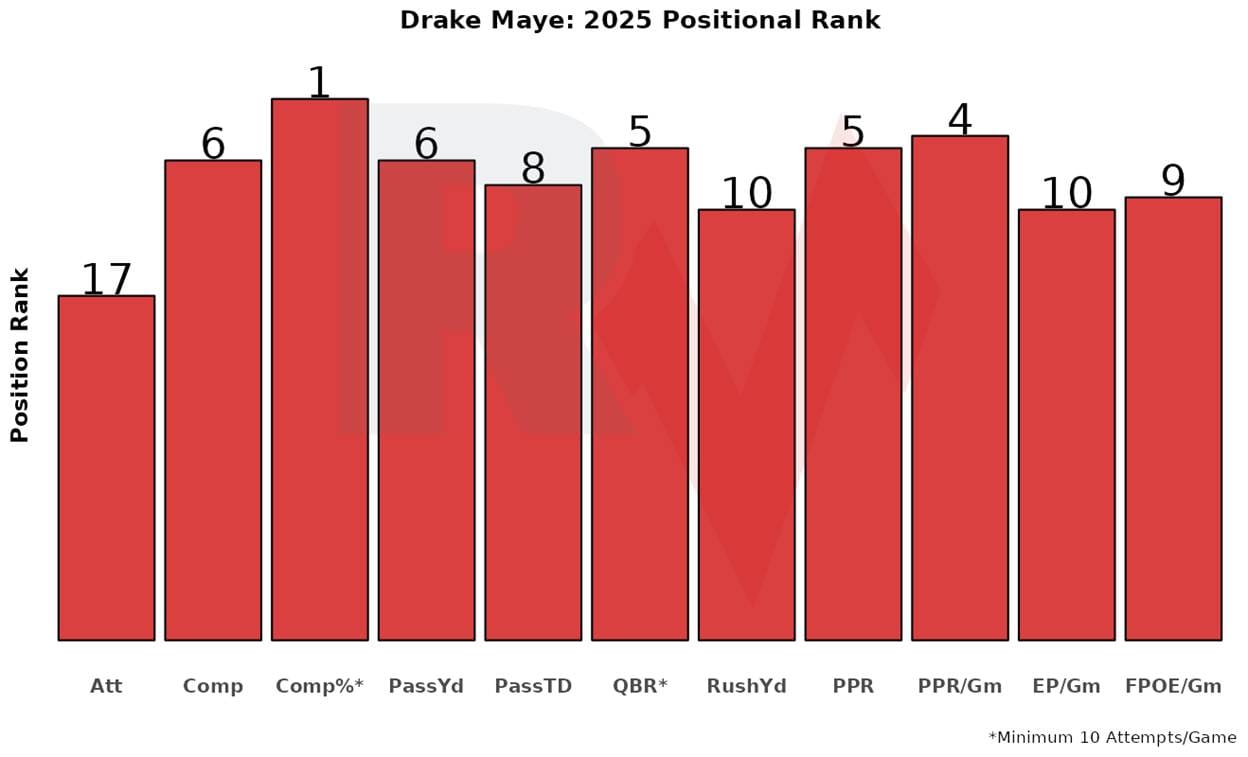
Maye has exhibited a good balance of efficiency and consistency, ranking fourth in EPA + CPOE composite. He has also been an effective runner, scrambling 15 times (3rd) for 89 scramble yards (9th), 98 rushing yards (10th), two rushing TDs (T-5th), and 10 rushing first downs (T-2nd). This is what we wanted if we were drafting Maye.
This all comes with the caveat that the Patriots have played the Raiders, Dolphins, Steelers, and Panthers—not exactly a murderer’s row. Of the four, only Carolina ranks in the top half in defensive dropback EPA or dropback success rate, and just barely. The Bills are a different story.
The Bills rank fourth in defensive dropback success rate and eighth in defensive dropback EPA. Their defense may have improved from their 2024 unit, which was oft-injured. As a whole, they took it on the chin in a Week 1 shootout against Baltimore, but they’ve settled since, ranking second, first, and first in passing yardage allowed over the last three weeks. They already look better in pass defense than they did all of last season.
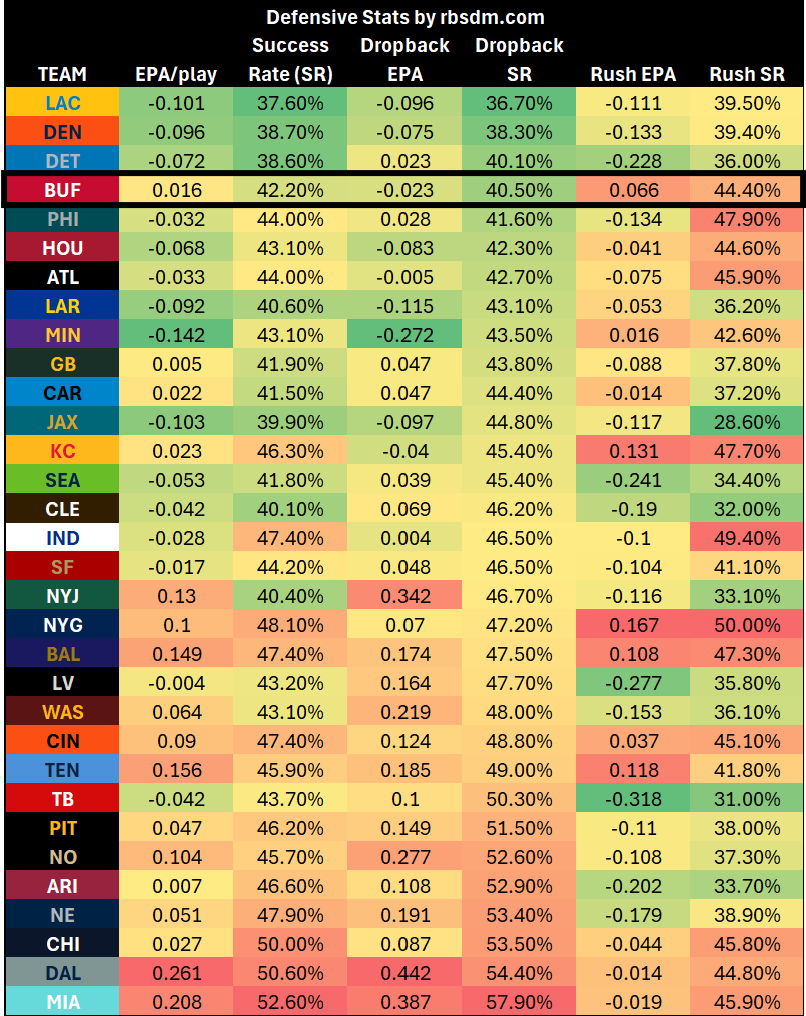
Of course, if we’re going to say this about Maye, we must be fair about Buffalo’s accomplishments, too; their competition has been weak other than Baltimore, so as stout as they look on said paper, it’s worth remembering that they’ve faced off against Spencer Rattler and two backups in their past five games, dating back to last year. And they couldn’t even collect a scalp from one of them, as Joe Milton played himself into public consciousness in Week 18.
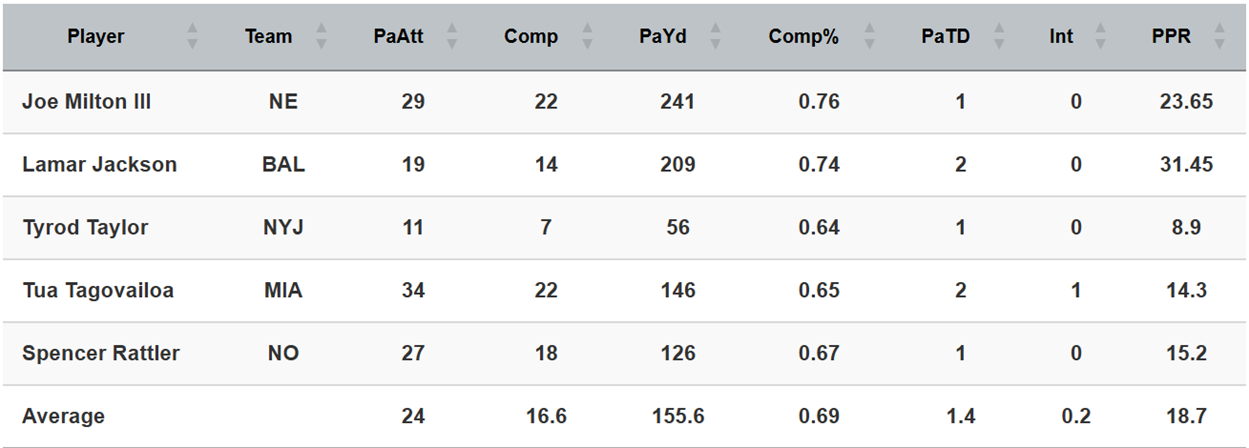
So far this season, the Bills have run zone on 74% of their plays (14th), and they use a 2-high safety look at a rate of 59.3% (6th). As most of us know by now, 2-high limits big plays down the sidelines outside of the hashes, surrendering more in the middle intermediate zone.
The Bills’ most popular alignment remains Cover 3 zone, a single-high alignment. Although this is the most popular alignment in the NFL, so it isn't surprising. The Bills still utilize it at a below-average rate (29.3%, 19th). They use Cover 2 zone at 21.1% (9th) and Cover 2 man at 5.7% (4th).
Based on Fantasy Points’ coverage matchup tool, the types and rates of coverage the Bills utilize are a slightly unfavorable matchup for Drake Maye (-3%, 21st). However, he is expected to score 0.51 fantasy points per dropback (FP/DB, 8th). Based on PFF’s matchup tool, the personnel presents a poor matchup for Maye, with a particular disadvantage for his WRs.
Based on the types and rates of coverage, Fantasy Points’ coverage matchup tool shows a slightly favorable matchup for WR Stefon Diggs at +4.1% and WR Kayshon Boutte at +1.6%, with every other WR or TE drawing an unfavorable matchup based on coverage and alignments. According to PFF’s personnel-based matchup tool, Diggs has a good matchup against specific players. However, it quickly deteriorates from there, with Boutte, TE Hunter Henry, and WR Mack Hollins all underwater.
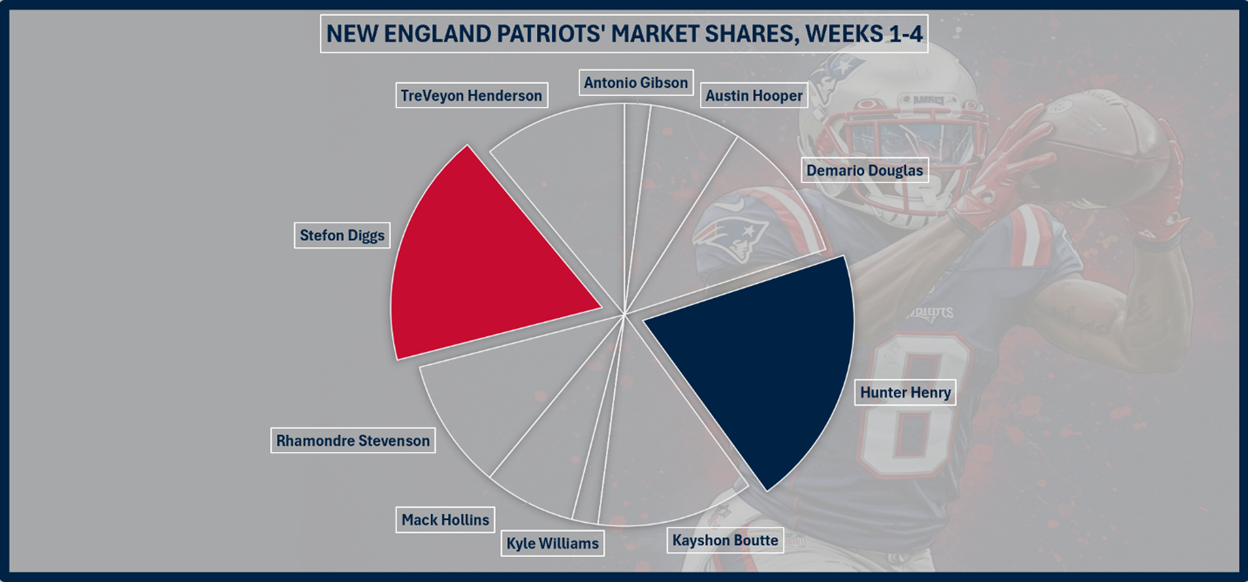
Diggs and Henry are the only Patriots' receiving options with a market share greater than 15%; there are many others involved, but they don’t warrant a significant amount of usage.
Boutte had a big day the last time these teams met with Milton under center, going 7-117-1. Boutte started the season like gangbusters, picking up right where he left off with a six-catch, 100-yard effort. He drew eight targets in that one; he’s drawn seven in the three games since. He’s not someone I’m excited to use, as he has fallen to 6.6 expected fantasy points (XFP) based on Fantasy Points’ data.
Diggs had a remarkable 41% market share last week against Carolina; obviously, we don’t expect that to sustain, but considering he is coming off a significant knee injury at an older age, it is encouraging to see him take this type of leap already. Diggs ranked third in the league last week in first read percentage (41%), seventh in targets per route run (TPRR, 41%), and he earned 0.94 FP/RR (11th).
He only ran 17 routes, so we’ll want to see that come up before we can feel like he’s reliable; even so, he’s already a good contrarian play, because he can make a lot from a little and still find some manner of upside.
As a season-long note, we would expect this route participation to grow as he gets healthier, and if Diggs can maintain these types of involvement percentages, he could ramp up to a nice back-end play, so he’s probably a buy. If his returns are modest against Buffalo in a tough matchup this Sunday, someone may view his Week 4 production as a fluke unlikely to repeat. However, most of the schedule going forward is relatively soft for Diggs and company.
Henry has ebbed and flowed some, but his highs have been high, drawing 11 and eight targets in two of his four games. Henry is the TE3 overall and ranks seventh in XFP. And thus far, he’s been a higher weighted opportunity guy, which provides some stability.
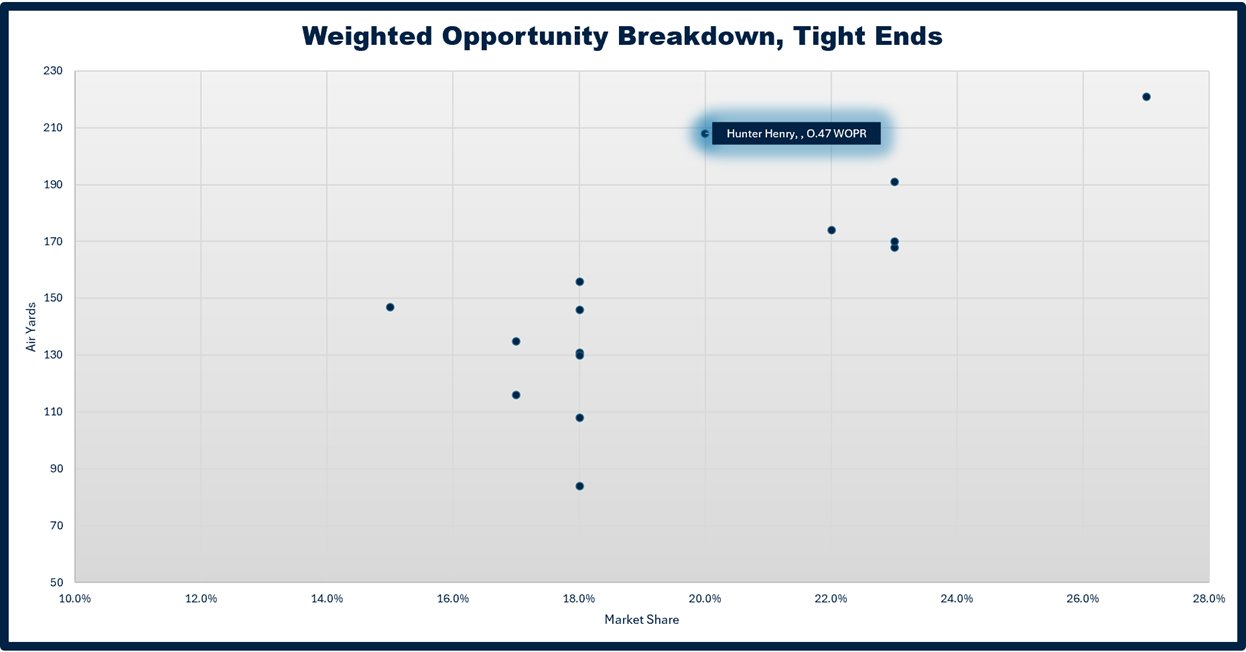
However, his efficiency is bolstered by a TD rate that is better than the league base rate by nearly two TDs already, based on simple TDs/Yds regression. This would represent the third-highest TD rate (12.5%) in Henry's ten-year career. That will probably come down, but maybe not; it could be a byproduct of the offense becoming significantly more functional. It isn’t a crazy rate, and, while it probablyi will steady, Henry absolutely could keep it going.
I called Henry out as one of my favorite late-round TEs this summer, and it's only gotten easier to stand by it. Any TE with a shot at being second on his team in targets is a good bet to be fantasy-viable.
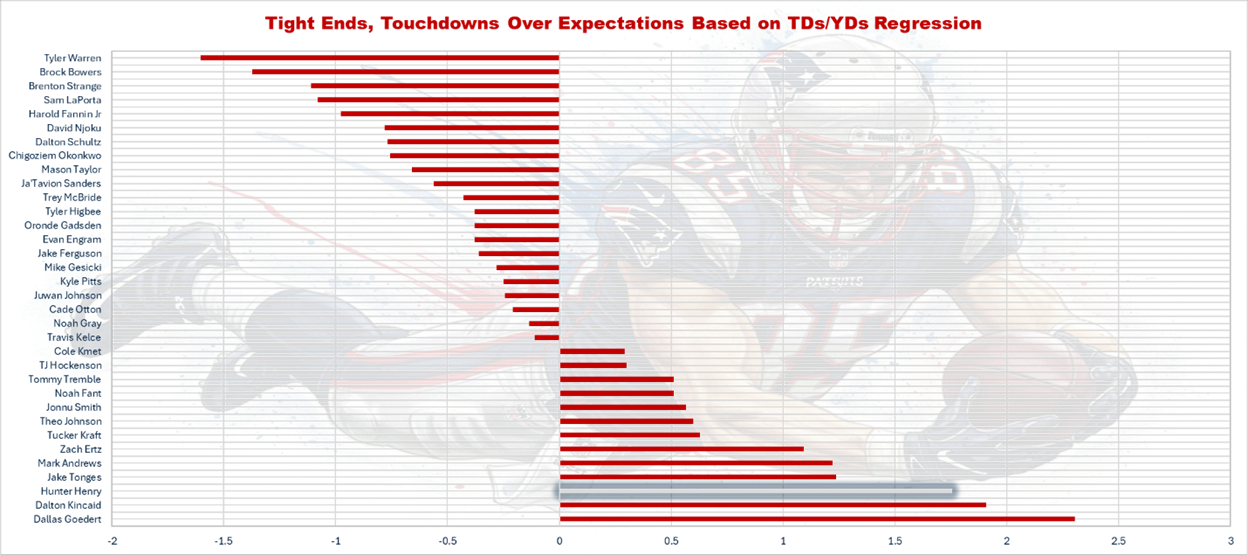
One area of the Patriots’ offense many fantasy GMs have their eye on is the RB usage. It is not unusual for a rookie RB to have to take their lumps for a few weeks as the team shows veteran deference to players who will not miss their assignments as frequently. However, there was a great deal of excitement about RB TreVeyon Henderson entering the season, and he’s remained second in the pecking order behind veteran RB Rhamondre Stevenson. Notably, RB Antonio Gibson is irrelevant for fantasy outside of the fact that he gets enough run to eat into the committee and further frustrate Stevenson and Henderson’s splits.
|
|
% of Team Atts |
Market Share |
XFP |
|
R. Stevenson |
29.5% |
9.7% |
35.3 |
|
T. Henderson |
24.8% |
10.5% |
34.5 |
|
A. Gibson |
18.1% |
1.6% |
15.5 |
Most Henderson GMs were cautiously optimistic heading into last week’s game after Stevenson had fumbled twice and Gibson once in Week 3. But Henderson only took a more significant backseat.
For what it’s worth, Henderson hasn't been very effective, posting a negative EPA/rush (-0.02) against relatively light boxes, and his explosive run percentage is only 3.5% (which was supposed to be his strength). This is still based on a small sample size, with just 39 touches, and Stevenson hasn’t been good either, recording -0.47 EPA/rush.
Playing Henderson at any point before he gets a respectable share is a guessing game at best, and of course, there is no guarantee that Henderson ever takes over. If you are building a DFS portfolio, he’s potentially worth an upside stab scattered throughout a bunch, but in managed leagues, he should be hands off until further notice.
Stevenson is almost as risky a play. The other side of the whole argument, of course, is that Henderson could take over at any moment; who knows when that's going to be a landmine for a Stevenson GM? As such, playing either doesn’t feel great.
That said, if one of the two can get a respectable workload on the ground (and my money is still on Stevenson at this point), he could make a decent play this week if the Pats can keep the game competitive.
For one, the Patriots are expected to have an advantage in run blocking based on adjusted yards before contact generated vs. adjusted yards before contact allowed.
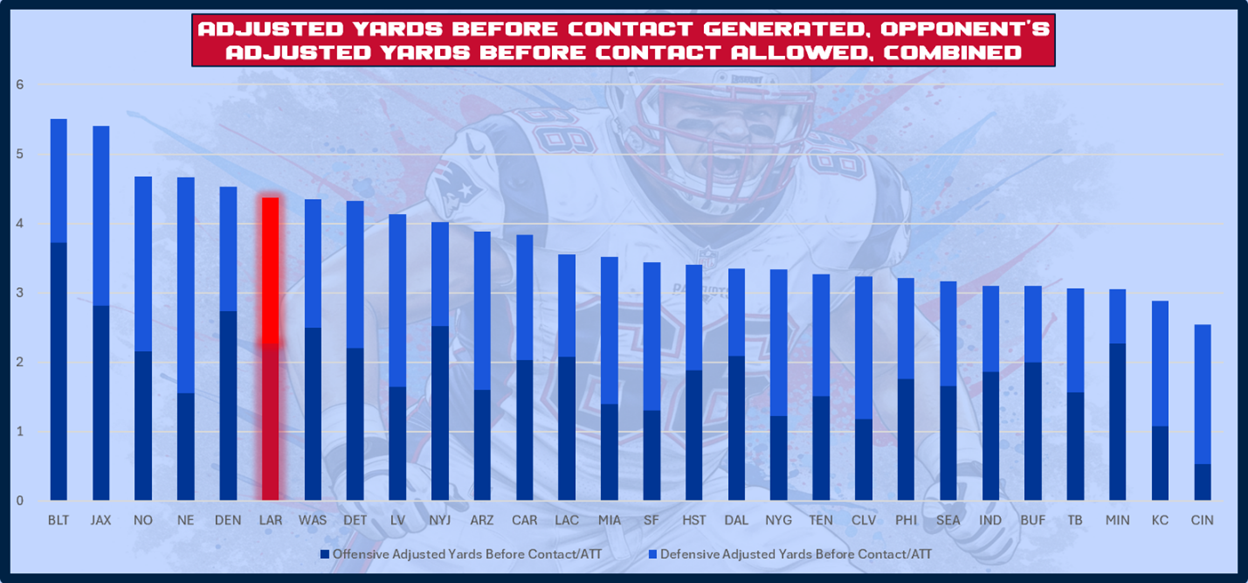
This is tremendous news, as this was expected to be the offense’s Achilles' heel. Instead, they seem to have hit on their early first-round pick, LT Will Campbell, who will be a key cog for years to come.
Pass-blocking, however, is another matter. The Patriots should suffer a severe disadvantage against the Bills’ front, as they allow a 12.01% (9th) pressure rate over expected (PrROE), while the Bills generate a 19.4% (2nd) PrROE.
Maye sees a significant drop in performance under pressure compared to playing from a clean pocket, shedding half of his QB rating points.
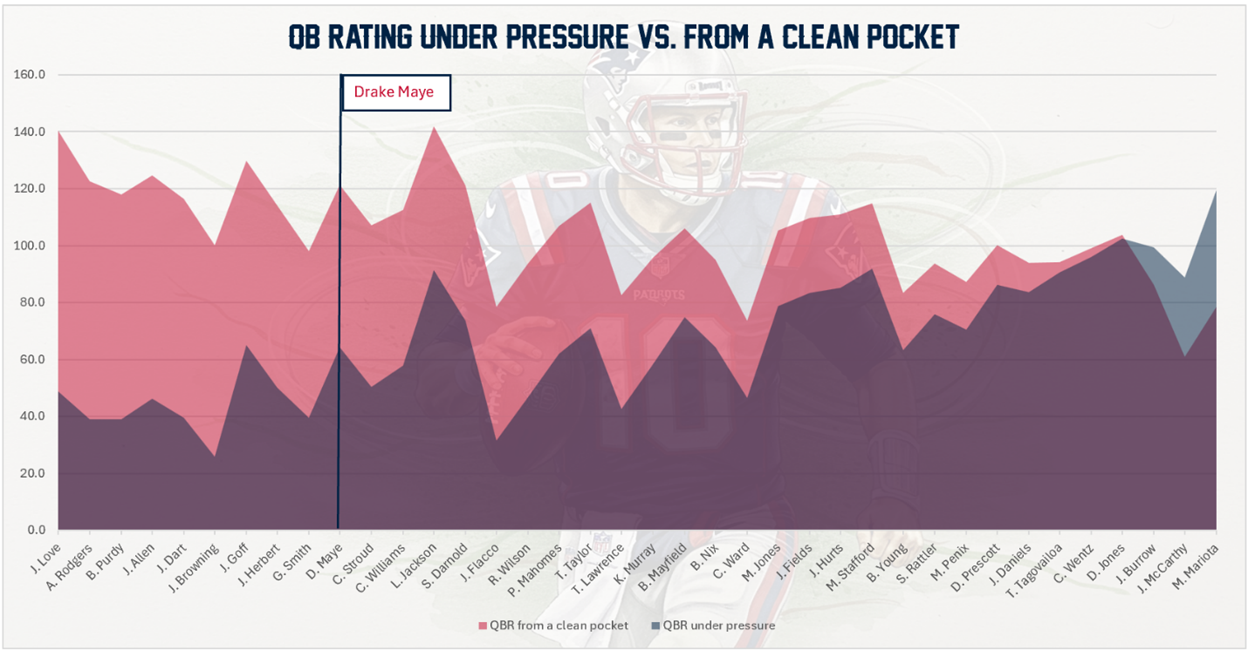
Maye has been sacked 13 times (4th), and his pressure-to-sack rate has been 26.0% (4th). Sacks are one thing, and they can be overcome (Joe Burrow, young Russell Wilson, young Aaron Rodgers), but pressure can’t manifest into frequent mistakes. So far, Maye has managed to avoid this, with only two turnover-worthy plays while pressured.
The Bills appear shockingly bad against the run, ranking 28th in defensive rush EPA and 21st in defensive rush success rate. This makes them appear as a significant run funnel. This all comes with a massive grain of salt. As I wrote already, the Week 1 affair against Baltimore was a major shootout, and Derrick Henry and Lamar Jackson ran roughshod; among the massive yardage totals, Henry had some incredibly long runs that could skew small-sample data.
It is also worth noting that DT Ed Oliver, arguably the Bills’ best defensive player, is expected to return this week from a three-week injury; this should make a massive difference inside.
The Bills’ run defense, which has been sturdy in recent seasons, should be better than the numbers suggest, and as they put some time between them and that first game, it should at least draw nearer to league average, if not better. I suggest that the run funnel is fool’s gold, and we shouldn’t expect Stevenson and Henderson actually to have the advantage that the numbers would seem to indicate.
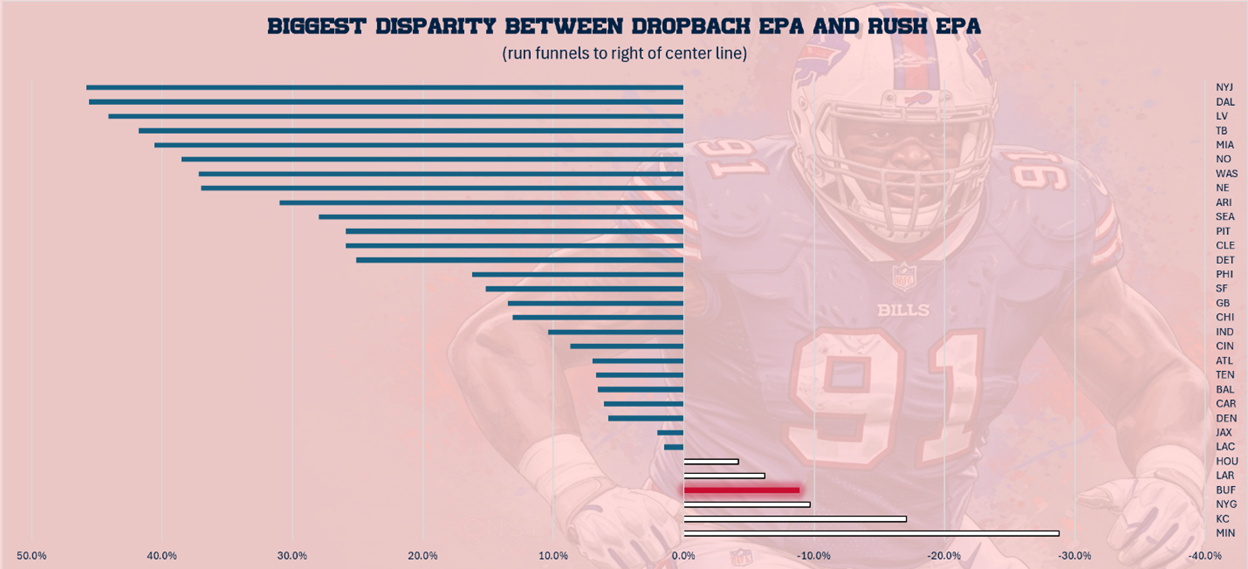
I wouldn’t be in a hurry to start Stevenson or Henderson; if I had to play one, I would choose Stevenson, but it will likely be a TD-dependent situation.
